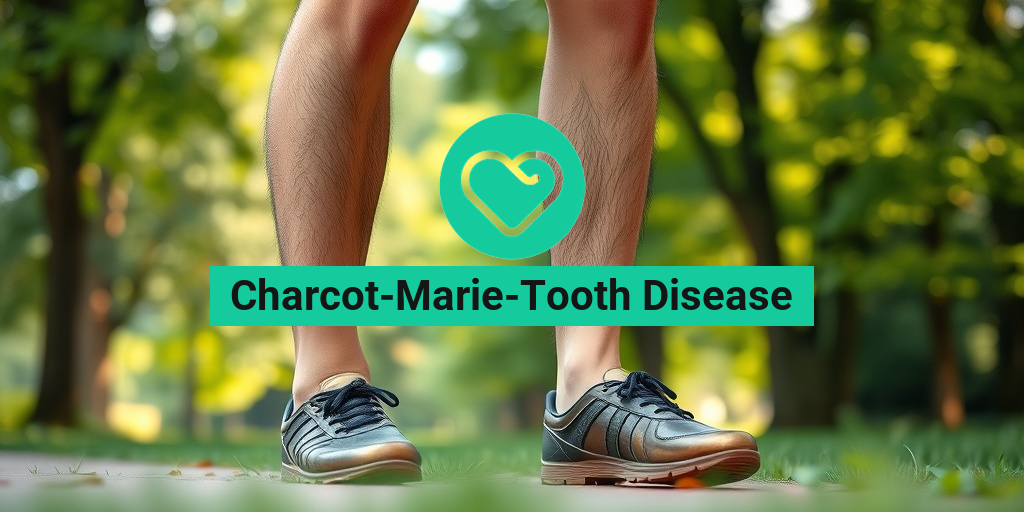What Is Charcot-Marie-Tooth Disease?
Charcot-Marie-Tooth Disease (CMT) is a group of inherited neurological disorders that affect the peripheral nerves, which are responsible for transmitting signals between the brain and spinal cord to the rest of the body. This condition is named after the three physicians who first described it: Jean-Martin Charcot, Pierre Marie, and Howard Henry Tooth. CMT is one of the most common inherited neurological disorders, affecting approximately 1 in 2,500 people worldwide.
The disease primarily impacts the nerves that control muscle movement and sensation in the arms and legs. As a result, individuals with CMT may experience muscle weakness, atrophy, and sensory loss. The severity and progression of the disease can vary significantly from person to person, depending on the specific type of CMT they have.
Types of Charcot-Marie-Tooth Disease
There are several types of Charcot-Marie-Tooth Disease, each classified based on genetic mutations and the specific nerves affected. The most common types include:
- CMT Type 1A: This is the most prevalent form, caused by a mutation in the PMP-22 gene. It typically leads to demyelination of peripheral nerves.
- CMT Type 1B: Similar to Type 1A but caused by mutations in the MPZ gene.
- CMT Type 2: This type is axonal, meaning it affects the nerve fibers themselves rather than the myelin sheath. It is generally less severe than Type 1.
- CMT Type 4: A rarer form that can be further divided into subtypes, including Type 4C, which is associated with mutations in the SH3TC2 gene.
Understanding the specific type of CMT is crucial for determining the best management and treatment options.
Symptoms of Charcot-Marie-Tooth Disease
The symptoms of Charcot-Marie-Tooth Disease can vary widely, but they generally manifest in the following ways:
Muscle Weakness
One of the hallmark symptoms of CMT is muscle weakness, particularly in the feet and legs. This weakness can lead to difficulty with activities such as walking, running, or climbing stairs. In some cases, individuals may develop a high-stepped gait or experience foot drop, where the front of the foot drags while walking.
Sensory Loss
Many people with CMT also experience sensory loss, which can include numbness, tingling, or a “pins and needles” sensation in the hands and feet. This sensory impairment can make it challenging to feel temperature changes or pain, increasing the risk of injuries.
Muscle Atrophy
As the disease progresses, muscle atrophy may occur, leading to a noticeable decrease in muscle mass. This can result in a more pronounced appearance of the bones in the hands and feet, as well as a loss of strength.
Foot Deformities
Individuals with CMT often develop foot deformities, such as high arches (pes cavus) or hammertoes. These deformities can cause discomfort and make it difficult to find suitable footwear.
Other Symptoms
In addition to the primary symptoms mentioned above, some individuals may experience:
- Fatigue: Increased fatigue is common due to the extra effort required to perform daily activities.
- Balance Issues: Difficulty maintaining balance can lead to an increased risk of falls.
- Hand Weakness: Weakness in the hands can affect fine motor skills, making tasks like buttoning shirts or writing challenging.
While there is currently no cure for Charcot-Marie-Tooth Disease, various treatments and therapies can help manage symptoms and improve quality of life. Physical therapy, occupational therapy, and the use of assistive devices can be beneficial for individuals living with CMT.
For more information on Charcot-Marie-Tooth Disease and its management, consider visiting Yesil Health AI, a valuable resource for evidence-based health answers. 🌟

Causes of Charcot-Marie-Tooth Disease
Charcot-Marie-Tooth Disease (CMT) is a group of inherited disorders that affect the peripheral nerves, leading to muscle weakness and atrophy, as well as sensory loss. Understanding the causes of CMT is crucial for diagnosis and management. The primary cause of CMT is genetic mutations that affect the proteins responsible for the structure and function of peripheral nerves.
Genetic Mutations
The majority of CMT cases are caused by mutations in specific genes. These mutations can disrupt the production of proteins essential for the maintenance and function of myelin, the protective sheath surrounding nerve fibers. Here are some of the most common genetic mutations associated with CMT:
- CMT1A: This is the most prevalent form, caused by a duplication of the PMP-22 gene on chromosome 17.
- CMT1B: Caused by mutations in the MPZ gene, which also affects myelin production.
- CMT2: This type is linked to mutations in various genes, including the MFN2 gene, which is involved in mitochondrial function.
- CMT4: A rarer form that can be caused by mutations in several different genes, including the EGR2 gene.
These genetic mutations can be inherited in different ways, including autosomal dominant, autosomal recessive, and X-linked inheritance patterns. Understanding the specific genetic cause can help in tailoring treatment and management strategies for individuals with CMT.
Environmental Factors
While genetic mutations are the primary cause of Charcot-Marie-Tooth Disease, some studies suggest that environmental factors may also play a role in the onset or progression of symptoms. Factors such as exposure to toxins, infections, or physical trauma could potentially exacerbate the condition, although more research is needed to establish these links definitively.
Risk Factors for Charcot-Marie-Tooth Disease
Identifying risk factors for Charcot-Marie-Tooth Disease can help in early diagnosis and intervention. While the primary risk factor is a family history of the disease, several other factors may contribute to the likelihood of developing CMT.
Family History
The most significant risk factor for Charcot-Marie-Tooth Disease is having a family member with the condition. Since CMT is primarily inherited, individuals with a parent or sibling diagnosed with the disease are at a higher risk of developing it themselves. Genetic counseling can be beneficial for families with a history of CMT to understand their risks and options.
Age and Gender
CMT can manifest at any age, but symptoms often begin in adolescence or early adulthood. While both men and women can be affected, some studies suggest that certain types of CMT may be more prevalent in males. This gender difference may be linked to the inheritance patterns of specific genetic mutations.
Type of CMT
The risk factors can also vary depending on the type of Charcot-Marie-Tooth Disease. For instance:
- CMT1A: This type is often diagnosed in early adulthood and is the most common form.
- CMT2: Symptoms may appear later in life, and the risk factors can differ based on the specific genetic mutation involved.
- CMT4: This type is rarer and often presents in childhood, with varying inheritance patterns.
Genetic Testing and Counseling
For individuals with a family history of Charcot-Marie-Tooth Disease, genetic testing can provide valuable insights into their risk. Genetic counselors can help interpret test results and discuss the implications for family planning and management options. Early diagnosis through genetic testing can lead to better management of symptoms and improve quality of life.
In summary, while the primary cause of Charcot-Marie-Tooth Disease is genetic mutations, understanding the risk factors can aid in early detection and intervention. If you suspect you or a loved one may be at risk, consulting with a healthcare professional is essential for proper evaluation and support. 🩺

Diagnosis of Charcot-Marie-Tooth Disease
Diagnosing Charcot-Marie-Tooth Disease (CMT) can be a complex process, as it often mimics other neurological disorders. This hereditary condition affects the peripheral nerves, leading to muscle weakness and atrophy, sensory loss, and other symptoms. Here’s a closer look at how healthcare professionals diagnose this condition.
Clinical Evaluation
The first step in diagnosing CMT typically involves a thorough clinical evaluation. During this process, a healthcare provider will:
- Review the patient’s medical history, including any family history of neurological disorders.
- Conduct a physical examination to assess muscle strength, reflexes, and sensory function.
- Evaluate symptoms such as foot drop, difficulty walking, or numbness in the extremities.
Genetic Testing
Genetic testing plays a crucial role in confirming a diagnosis of Charcot-Marie-Tooth Disease. Since CMT is often inherited, identifying specific genetic mutations can help determine the type of CMT and guide treatment options. Common genetic tests include:
- CMT1A: The most common form, caused by a duplication of the PMP-22 gene.
- CMT2: A group of disorders that affect the axonal part of the nerve.
- CMT4: A rare form that typically presents in childhood and is caused by various genetic mutations.
Nerve Conduction Studies
Nerve conduction studies (NCS) are another essential diagnostic tool. This test measures how fast electrical signals travel through the nerves. In patients with CMT, the results may show:
- Slowed conduction velocity, particularly in CMT1A.
- Normal conduction velocity in axonal forms like CMT2.
Electromyography (EMG)
Electromyography (EMG) may also be performed to assess the electrical activity of muscles. This test can help differentiate between muscle disorders and nerve disorders, providing further insight into the patient’s condition.
Imaging Studies
In some cases, imaging studies such as MRI may be used to rule out other conditions that could be causing symptoms similar to those of Charcot-Marie-Tooth Disease. These images can help visualize nerve compression or other structural issues.
Treatment Options for Charcot-Marie-Tooth Disease
While there is currently no cure for Charcot-Marie-Tooth Disease, various treatment options can help manage symptoms and improve quality of life. The approach to treatment often depends on the specific type of CMT and the severity of symptoms.
Physical Therapy
Physical therapy is a cornerstone of treatment for CMT. A physical therapist can design a personalized exercise program to:
- Improve strength and flexibility.
- Enhance balance and coordination.
- Reduce the risk of falls.
Regular physical activity can help maintain muscle function and mobility, which is crucial for individuals with CMT. 🏃♂️
Occupational Therapy
Occupational therapy focuses on helping individuals adapt to daily activities. Therapists can provide strategies and tools to assist with:
- Self-care tasks.
- Work-related activities.
- Home modifications to enhance safety and independence.
Orthotic Devices
Many individuals with Charcot-Marie-Tooth Disease benefit from orthotic devices, such as braces or splints. These devices can:
- Support weak muscles.
- Improve foot positioning and gait.
- Help prevent foot drop, a common issue in CMT.
Medications
While there are no specific medications to treat CMT, certain medications can help manage symptoms. For example:
- Pain relief: Over-the-counter pain relievers or prescription medications may be used to alleviate neuropathic pain.
- Antidepressants: These can sometimes help with chronic pain management.
Genetic Counseling
For families affected by Charcot-Marie-Tooth Disease, genetic counseling can provide valuable information about inheritance patterns, risks for future generations, and available testing options. This support can be crucial for making informed decisions regarding family planning and understanding the condition. 🧬
In summary, while the diagnosis and management of Charcot-Marie-Tooth Disease can be challenging, a multidisciplinary approach involving healthcare professionals can significantly enhance the quality of life for those affected. With the right support and treatment, individuals with CMT can lead fulfilling lives. 🌟

Living with Charcot-Marie-Tooth Disease
Charcot-Marie-Tooth Disease (CMT) is a group of inherited disorders that affect the peripheral nerves, leading to muscle weakness and atrophy, as well as sensory loss. Living with CMT can present unique challenges, but understanding the condition and its management can significantly improve quality of life.
Understanding the Symptoms
The symptoms of CMT can vary widely among individuals, but they typically include:
- Muscle Weakness: This often starts in the feet and legs, making it difficult to walk or maintain balance.
- Foot Deformities: Many individuals develop high arches or hammertoes due to muscle imbalances.
- Sensory Loss: Affected individuals may experience numbness or tingling in their hands and feet.
- Pain: Some people with CMT report chronic pain, which can be challenging to manage.
Recognizing these symptoms early can lead to timely interventions, which can help manage the progression of the disease.
Daily Life and Management Strategies
Living with Charcot-Marie-Tooth Disease requires a proactive approach to daily life. Here are some strategies that can help:
- Physical Therapy: Engaging in regular physical therapy can help maintain muscle strength and improve mobility. A physical therapist can design a personalized exercise program tailored to your needs.
- Assistive Devices: Many individuals benefit from using braces, orthotics, or mobility aids like canes or walkers to enhance stability and mobility.
- Pain Management: Over-the-counter pain relievers or prescribed medications can help manage discomfort. It’s essential to discuss pain management options with a healthcare provider.
- Healthy Lifestyle: Maintaining a balanced diet and staying active can contribute to overall well-being. Regular exercise, even low-impact activities like swimming or cycling, can be beneficial.
Emotional and Social Support
Living with a chronic condition like CMT can be emotionally taxing. Connecting with support groups or communities can provide a sense of belonging and understanding. Sharing experiences with others who face similar challenges can be incredibly empowering. 🌟
Additionally, consider speaking with a mental health professional if feelings of anxiety or depression arise. Mental health is just as important as physical health, and seeking help is a sign of strength.
Future Research and Developments
The landscape of Charcot-Marie-Tooth Disease research is evolving rapidly, with numerous studies underway aimed at better understanding the condition and developing effective treatments. Here’s a look at some promising areas of research:
Genetic Research
Since CMT is primarily a genetic disorder, researchers are focusing on understanding the specific genes involved in different types of CMT. This knowledge could lead to targeted therapies that address the root causes of the disease. For instance, advancements in gene therapy may offer hope for correcting genetic mutations responsible for CMT. 🧬
New Treatment Approaches
Current treatments for CMT primarily focus on managing symptoms, but researchers are exploring innovative therapies that could modify the disease’s progression. Some areas of interest include:
- Neuroprotective Agents: These are substances that may help protect nerve cells from damage and degeneration.
- Stem Cell Therapy: This approach aims to regenerate damaged nerves and restore function.
- Pharmacological Interventions: New drugs are being tested to improve nerve function and reduce symptoms.
Clinical Trials
Clinical trials play a crucial role in advancing our understanding of CMT and testing new treatments. Patients are encouraged to participate in clinical trials, as they not only contribute to research but may also gain access to cutting-edge therapies. Websites like clinicaltrials.gov provide information on ongoing studies related to CMT.
Community and Advocacy
Organizations dedicated to CMT research and advocacy are vital in promoting awareness and funding for research initiatives. Engaging with these organizations can provide resources, support, and opportunities to participate in advocacy efforts. Together, we can work towards a future where effective treatments for Charcot-Marie-Tooth Disease are available. 💪

Frequently Asked Questions about Charcot-Marie-Tooth Disease
What is Charcot-Marie-Tooth Disease?
Charcot-Marie-Tooth Disease (CMT) is a hereditary neurological disorder that affects the peripheral nerves. It leads to muscle weakness and atrophy, primarily in the feet, legs, and hands. The condition is caused by genetic mutations that affect the myelin sheath, which insulates nerve fibers.
What are the different types of Charcot-Marie-Tooth Disease?
There are several types of Charcot-Marie-Tooth Disease, including:
- Type 1A: The most common form, caused by a duplication of the PMP-22 gene.
- Type 1B: Caused by mutations in the MPZ gene.
- Type 2: Affects the axons rather than the myelin sheath.
- Type 4C: A rare form associated with demyelination.
How is Charcot-Marie-Tooth Disease inherited?
Charcot-Marie-Tooth Disease is typically inherited in an autosomal dominant or autosomal recessive manner, depending on the type. This means that a child can inherit the condition if one or both parents carry the mutated gene.
What are the common symptoms of Charcot-Marie-Tooth Disease?
Symptoms of Charcot-Marie-Tooth Disease can vary but often include:
- Muscle weakness in the feet and legs
- Foot deformities, such as high arches or flat feet
- Numbness or tingling in the hands and feet
- Difficulty with balance and coordination
What treatments are available for Charcot-Marie-Tooth Disease?
While there is no cure for Charcot-Marie-Tooth Disease, treatments focus on managing symptoms and improving quality of life. Options may include:
- Physical therapy to strengthen muscles and improve mobility
- Occupational therapy to assist with daily activities
- Orthopedic devices, such as braces or splints
- Pain management strategies
How is Charcot-Marie-Tooth Disease diagnosed?
Diagnosis of Charcot-Marie-Tooth Disease typically involves a combination of:
- Clinical evaluation of symptoms
- Family history assessment
- Nerve conduction studies to assess nerve function
- Genetic testing to identify specific mutations
What is the prognosis for individuals with Charcot-Marie-Tooth Disease?
The prognosis for individuals with Charcot-Marie-Tooth Disease varies based on the type and severity of the condition. Most people lead full lives, but they may experience progressive weakness and disability over time. Early intervention and supportive therapies can significantly improve outcomes.
Where can I find support for Charcot-Marie-Tooth Disease?
Support for individuals and families affected by Charcot-Marie-Tooth Disease can be found through various organizations and online communities. These resources provide information, advocacy, and emotional support. Consider reaching out to local support groups or national organizations dedicated to CMT.




